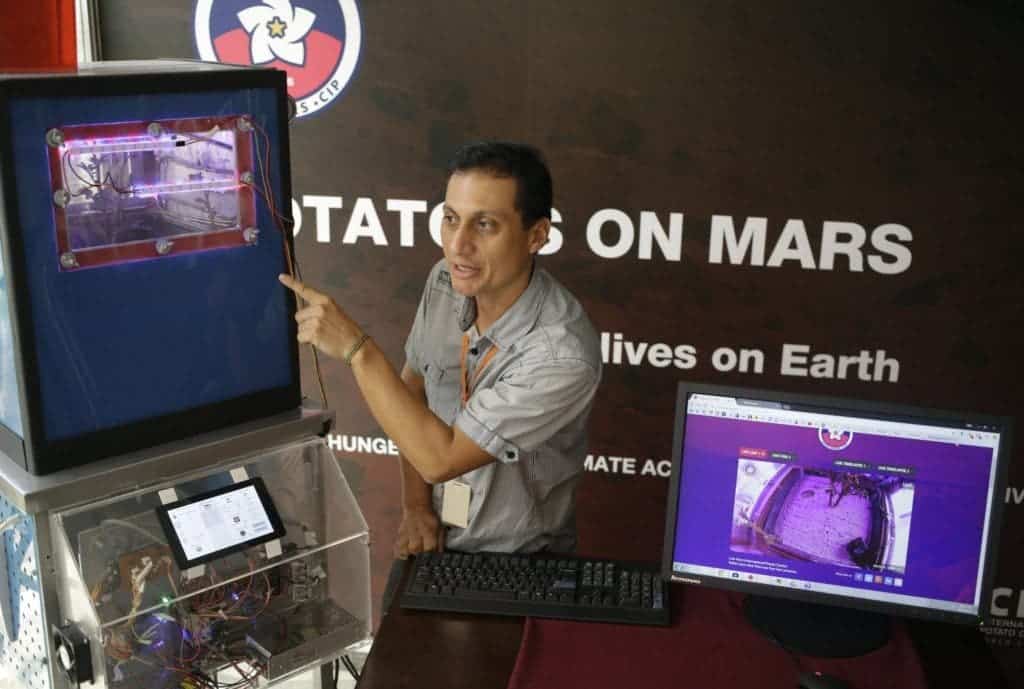
Not long after Matt Damon played a stranded botanist on Mars who had to grow his own potatoes there to avoid starvation, scientists from the International Potato Center (IPC) in Lima, Peru, began an ambitious project to grow potatoes in Mars-like conditions. A year later, some of the first results are in and they’re very promising. By all accounts, it seems the potato is on its way to becoming the first interplanetary crop.
“Growing crops under Mars-like conditions is an important phase of this experiment,” says Julia Valdivia-Silva, a researcher working on the project. “If the crops can tolerate the extreme conditions that we are exposing then to in our CubeSat, they have a good chance to grow on Mars. We will do several rounds of experiments to find out which potato varieties do best.”
Peru, the ancient land of the Incas, is where the first domesticated potatoes were grown about 7,000 years ago. Today, in Peru, Bolivia and Ecuador alone, some 4,000 varieties of potato are grown, some of which can sprout even in the most barren conditions. Among the ages, its resilience and high nutritional value have made the potato into a key staple crop. Today, the potato is one of the most favored foods globally, along with wheat and rice.
It seems fitting that the first experiments meant to assess whether a potato can grow on Mars were held in Lima, Peru’s capital. Some 100 varieties were tested by the IPC researchers, who were joined by colleagues from the University of Engineering and Technology (UTEC) in Lima and NASA’s Ames Research Center. Each variety was grown inside a Mars-in-a-box test chamber called a CubeSat, which is typically a tiny satellite used in space research but this time just the hermetically shut casing was used.
Inside the CubeSat, Mars-like conditions were simulated like below-zero temperatures, high carbon monoxide concentrations, low air pressure found at 6,000 meters (19,700 feet) altitude. Additionally, a system of lights imitated the Martian day and night. As for the soil, the researchers looked for something with high salinity that would mirror the barren Martian ground as closely as possible. They didn’t have to look too far for it. Along Peru’s southern coast, at Pampas de la Joya, there is less than a millimeter of rain a year and the parched ground here proved fitting.
Of the 100 varieties planted by the researchers, 40 are native to the Andes Mountains, the birthplace of the potato, while the other 60 or so were improved varieties that can better cope in low-water conditions or have heightened immunity against viruses. Just four varieties managed to sprout from the soil. A variety called “Unique” seems to be the clear winner. You can even see some of these varieties as they grow in this live feed provided by NASA.
“It’s a ‘super potato’ that resists very high carbon dioxide conditions and temperatures that get to freezing,” the IPC researchers said in a statement.
It’s important to note that all of these tests didn’t simulate conditions on Mars in the open. Given the planet’s low-pressure, freezing temperature and lack of oxygen, it would be likely impossible for any plant to survive but inside a greenhouse-type environment is another thing, and the present research clearly shows it’s possible. That was the point, after all.
Some day, when mankind is ready to permanently colonize Mars, it’s likely that food crops would be deployed in advance, on a separate spacecraft. Once in the Martian orbit, automated systems, robots and artificial intelligence can deploy a habitat for the manned crew but also a greenhouse. By the time the first long-term human expedition reaches the site on Mars, some of the crops should have already been harvested. For this to work, though, you need to establish the upper and lower limits of survivability for your crops, which is why new experiments will see even higher carbon dioxide concentrations to more closely imitate the Martian atmosphere.
Previously, scientists have grown other crops as well in Martian soil, albeit not in Mars-like atmospheric conditions. These include tomatoes, peas, rye, garden rocket, radish and garden cress. Another study found some of these foods were actually healthier than their Earth-grown counterparts.
Growing super potatoes in Mars-like conditions can help food security here on Earth, as well. The lessons learned and the technology developed from these experiments could push the potato from its current status of fifth most important crop grown worldwide (after wheat, corn, rice and sugarcane) to the #1 slot. In the face of ever uncertain conditions due to climate change, knowing we always have a crop or two to point at that can grow even on Mars is reassuring on so many levels.
“The results indicate that our efforts to breed varieties with high potential for strengthening food security in areas that are affected, or will be affected by climate change, are working,” IPC researchers said.


